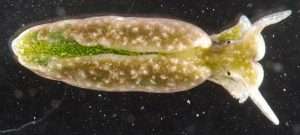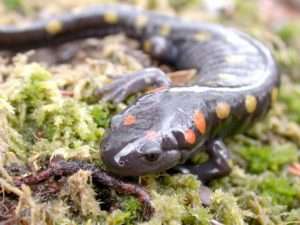Photosynthesis is an incredible process if you think about it. Using special cells called chloroplasts, photosynthetic beings are able to absorb energy from sunlight and convert it into chemical energy that can be used for immediate metabolic needs, or stored away as glucose for the future. This energy is the basis of the entire food web, as various beings eat other beings and absorb their stored energy. In essence, whenever any living being consumes another, they are eating condensed sunlight (with some other additives like carbon, of course.) Plants, algae, and cyanobacteria make up the bulk of photosynthesizers–but did you know there are photosynthetic animals, too?
Photosynthetic Animals – Invertebrates

The majority of this very exclusive club are aquatic invertebrates. Among the best known examples are a group of sea slugs and sea snails within the superorder Sacoglossa, such as members of the genus Elysia like E. chlorotica, E. clarki, E. pusilla, and E . viridis. The sea slugs feed on various species of algae, and retain the chloroplasts in their digestive systems for months after the algae has been otherwise digested. This allows the sea slugs to use the chloroplasts as a secondary source of food. Scientists aren’t yet sure whether the molluscs are able to absorb the energy directly from the chloroplasts like the algae does, or whether they simply slowly digest the chloroplasts whose existence and energy levels are lengthened by ongoing photosynthesis.
Some animals create a mutually beneficial relationship with photosynthesizers, rather than consuming them and stealing the chloroplasts for their own use. Corals have symbiotic relationships with zooanthellae algae, which take shelter in the tissues of the soft-bodied corals while swapping nutrients with them. The devastating phenomenon known as coral bleaching occurs when the coral pushes the algae out due to stress; this leads to the death of both coral and algae.
Zooanthellae also partners with the upside-down jellyfish (Cassiopea xamachana), and as with coral the algae nestles within its partner’s tissues. Several species of Hydra, another cnidarian, represent yet another partner for the zooanthellae. Similarly, the Roscoff worm (Symsaggitifera roscoffensis) allows the microalgae Tetraselmis convolutae to find shelter in its skin in exchange for nutrients from photosynthesis. Other marine invertebrates that have symbiotic relationships with various photosynthetizers include the sponge Neopetosia subtriangularis, the tunicate Didemnum molle, and giant clams in the genus Tridacne.
A couple of types of terrestrial invertebrate have displayed traits that may be related to photosynthesis. The oriental hornet (Vespa orientalis) could be able to harvest energy from sunlight through yellow pigment in the cuticle of its exoskeleton. However, this is only suggested through one paper, and further research is needed. Another paper posits that pea aphids (Acyrthosiphon pisum) have similar carotenoids to those found in chloroplasts and that the insects may be able to produce a form of photosynthesis with them.
Photosynthetic Animals – Vertebrate, Singular
 Finally we come to the only known photosynthetic vertebrate. The spotted salamander’s (Ambystoma maculatum) eggs absorb the algae Oophila amblystomatis while the embryos are still developing. The algae provides carbon to them while removing ammonia and increasing available oxygen. Sadly, as habitat destruction and pollution, including herbicides like Atrazine, kill off the beneficial algae, the hatch rates of spotted salamanders decrease significantly. While the salamanders no longer rely on the algae once they’re hatched, if fewer eggs hatch successfully, there will be fewer salamanders to carry on new generations.
Finally we come to the only known photosynthetic vertebrate. The spotted salamander’s (Ambystoma maculatum) eggs absorb the algae Oophila amblystomatis while the embryos are still developing. The algae provides carbon to them while removing ammonia and increasing available oxygen. Sadly, as habitat destruction and pollution, including herbicides like Atrazine, kill off the beneficial algae, the hatch rates of spotted salamanders decrease significantly. While the salamanders no longer rely on the algae once they’re hatched, if fewer eggs hatch successfully, there will be fewer salamanders to carry on new generations.
